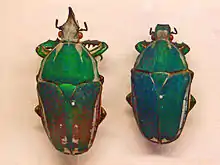Mecynorhina torquata
Mecynorhina torquata is a beetle from the subfamily Cetoniinae, tribe Goliathini.
| Mecynorhina torquata | |
|---|---|
 | |
| Mecynorrhina torquata, male and female. Mounted specimen at the National Museum (Prague) | |
| Scientific classification | |
| Kingdom: | |
| Phylum: | |
| Class: | |
| Order: | |
| Family: | |
| Genus: | |
| Species: | M. torquata |
| Binomial name | |
| Mecynorhina torquata (Drury, 1782) | |
| Synonyms | |
| |
Description
Mecynorhina torquata is among the largest flower beetles in the world, only surpassed by the goliath beetles. It reaches about 55–85 millimetres (2.2–3.3 in) of length in the males, while the females are slightly smaller, reaching about 50–60 millimetres (2.0–2.4 in) of length. The basic colour is green with whitish markings on the elytra. The males have a horn in the forehead. The larvae can reach about 80 millimetres (3.1 in) of length in the males, with a weight of about 30-40g.
Distribution
These beetles are native to tropical Africa, especially in the Democratic Republic of the Congo, Cameroon and Uganda.
Research
Cyborgs of M. torquata have been created by implanting electrodes and a radio device.[1][2] By sending radio signals to make the electrodes stimulate the muscles, it is possible to control the beetle's walking[1] and flight.[2]
Subspecies
- Mecynorhina torquata immaculicollis (Kraatz, 1890)
- Mecynorhina torquata poggei (Kraatz, 1890)
- Mecynorhina torquata torquata (Drury, 1782)
- Mecynorhina torquata ugandensis Moser, 1907 – sometimes treated as a separate species
References
- Cao, Feng; Zhang, Chao; Choo, Hao Yu; Sato, Hirotaka (2016). "Insect–computer hybrid legged robot with user-adjustable speed, step length and walking gait". Journal of the Royal Society Interface. 13 (116): 20160060. doi:10.1098/rsif.2016.0060. ISSN 1742-5689. PMC 4843679. PMID 27030043.
- Sato, Hirotaka; Vo Doan, Tat Thang; Kolev, Svetoslav; Huynh, Ngoc Anh; Zhang, Chao; Massey, Travis L.; van Kleef, Joshua; Ikeda, Kazuo; Abbeel, Pieter; Maharbiz, Michel M. (2015-03-16). "Deciphering the Role of a Coleopteran Steering Muscle via Free Flight Stimulation". Current Biology. 25 (6): 798–803. doi:10.1016/j.cub.2015.01.051. ISSN 0960-9822. PMID 25784033. S2CID 4906874.